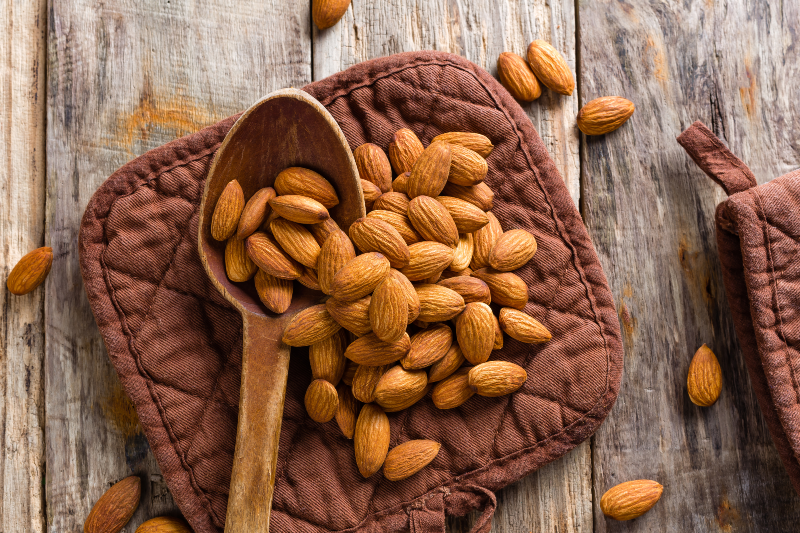The diabetic-friendly diet contains foods used for regulating blood glucose levels. Reduced blood sugars aid to avoid diabetes complications. People must avoid foods that enhance the levels of blood sugars. Better blood glucose control may help a diabetic to live a normal life. Diabetics need to draw a clear line between nutritious and poor foods.
There are a few foods that may make blood sugar control easy. Similarly, almonds are one of those healthy nuts for diabetics. Almonds are full of healthy nutrients that form a part of everybody’s diet. However, this incredible nut may make blood sugar control an easy task.
Diabetes Meal Plan: Almonds for Diabetes

Almonds are completely packed with vital nutrients. Almonds have the potential of regulating blood glucose levels. Many studies also recommend that almonds can drop glucose levels naturally.
Among all the nuts, almonds are one of the most excellent of those. Almonds pack essential nutrients and pack calories also. Badam or almond is a great mid-time snack for a person with diabetes. Badam contains magnesium and this mineral makes it useful for diabetics. It helps to regulate normal blood sugar level after meal.
Some research also supports that almonds if had in a good amount for a longer time may aid in regulating blood sugars. Since heart disorders are one of the complications of diabetes. Almonds help to improve heart health in diabetics and lower their risk of cardiac problems too.
High in Good Fats
Almonds have rich amounts of monounsaturated fats. They are heart-supportive fat related to a lowered risk of cardiovascular problems. In addition, almonds contain, rich antioxidants, vitamin E, potassium, and magnesium. Magnesium works great in improving the flow of oxygen, blood, and nutrients all over the body. Moreover, potassium is a vital electrolyte involved in muscle contraction and nerve transmission.
Research Support
Almonds are just great in regulating blood sugars and lowering the risk of heart diseases in type 2 diabetics. Also, it is found to be rich in magnesium and Vitamin E. Both are known to promote normal blood pressure, healthy bones, and healthy nerve and muscle functioning. An ounce of almonds prior to having a low carb diet may cause a 30% decrease in post-meal sugar levels for type 2 diabetics.
Also, almonds are great in lowering bad cholesterol, i.e., small solid particles of low-density lipoprotein (LDL). An excess of these may block the arteries.
For diabetic patients, adding almonds to diets seems to reduce post-meal spikes in blood glucose and insulin levels. Besides, consuming almonds in combination with a high GI food considerably reduces the GI of the complete diet and lowers the spikes in blood glucose after consumption. Another study observed that swapping 20% of dietary calories with almonds led to better markers of insulin sensitivity as well as reduced cholesterol levels in prediabetics.
Ways of Taking Almonds
Many dieticians state that diabetics must not have salted or fried almonds that come on the market. It is better to give raw almonds to diabetics. People may eat almonds in the early morning or as an evening snack.
They are rich in calories hence if a person is including almonds in their meal, it is important to lower the overall calorie consumption. This helps in preventing weight gain. If a person with diabetes in having normal calories, including almonds would tremendously increase the total calorie count. Thus, people must control other calories prior to intake of almonds to regulate their glucose levels.
Recommended Number of Almonds for a Day
Generating stability of calories and intake of almonds would certainly give positive results to a diabetic person. People must eat six to eight almonds in a day, however, for a diabetic, the amount must be more. It is very critical to regulating the complete calorie count. However, the safe limit is six to eight almonds.
Some Tips for Including Almonds in One’s Diet
- Spread almond butter rather than peanut butter on whole-wheat bread or toast.
- Take almonds as a snack along with a piece of fruit.
- Make use of unsweetened almond milk in sauces, shakes, eggnog, or other recipes.
- Chop almonds and include them in pasta, rice, or saute veggies for an extra crunch.
- Make use of finely chopped almonds instead of bread crumbs over baked casseroles.
- Top salads using almonds that are lightly toasted in the oven.
- People can use almond flour (also called almond meal) in several diabetes-friendly recipes.
Read More: Complete Guide To Understanding Anxiety





